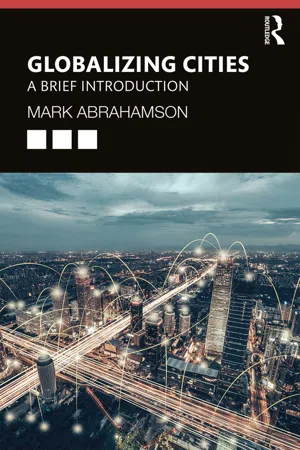
- 216 pages
- English
- ePUB (mobile friendly)
- Available on iOS & Android
About This Book
Globalization has been built upon, and maintained by, major urban centers. As the interconnections among these cities grow, more cities become involved as important global nodes, and globalization has an extremely strong influence upon the forms and functions of cities everywhere. This new textbook examines modern cities worldwide through two lenses: as the major nodes in the global economy, and as primary propagators of cultural ideas across the world.
Exploring the ramifications of the continuing penetration of global forces into smaller urban areas, this book clearly distinguishes economic, cultural, and political processes to demonstrate how global attachments are shaping many of the basic features of modern cities. Specifically, the book examines the way cities accommodate huge global flows of people, including migrants, tourists, and the managers of multi-national firms, and the effects this has upon the cultural, economic, and political forces associated with globalization in cities. The main features of the book include:
-
- a balanced emphasis upon how economic, technological, and cultural forces shape both urban and global developments;
- a highly interdisciplinary focus, incorporating major works and ideas from urban scholars writing in sociology, geography, anthropology, and politics;
- detailed case studies of events and activities within specific cities and regions that illuminate major trends;
- end of chapter reading lists of corresponding chapters in The Globalizing Cities Reader, second edition, edited by Xuefei Ren and Roger Keil and published by Routlegde in 2018.
Written in a clear and accessible style, Globalizing Cities: A Brief Introduction will appeal to advanced undergraduate and postgraduate students in both urban and globalization courses within sociology, geography, and urban studies.
Frequently asked questions
Information
CHAPTER 1
The history of globalization
DIMENSIONS OF GLOBALIZATION
- Economic, entailing the international flow of capital, goods and services as well as forms of business and commercial organization (e.g. transnational organizations). It is typically measured by a variety of statistics relating to imports, exports, and investments.
- Social-cultural, which involves a diffusion of values, ideas, and images that shape people’s identities and the types of relationships and recreational forms they favor. Relevant indicators often include tourism and international media flows, broadly defined to include movies, newspapers, recorded music, etc.
- Governmental-political, entailing the degree to which agreements, treaties, and shared rules control the flow of people and goods across national boundaries, and define the locus of citizenship. Measurement frequently includes the number of signed treaties and embassies and immigration rules.
THE KOF INDEXES
- Globalization: An overall measure that combines the economic, governmental, and social-cultural indexes, as described below.
- Economic, which combines two sub-dimensions:2a. Economic flows: a nation’s imports, exports, and foreign investments.2b. Restrictions on trade, involving tariff rates and hidden import barriers.
- Governmental-political: Embassies located in a nation, the nations’ number of memberships in international organizations and number of treaties signed with other nations.
- Social-cultural, which has three sub-dimensions:4a. Transnational personal contacts involving telecommunications and mailed letters.4b. Potential flow of ideas and images, indicated by the number of internet users, households with television sets and Internet and international newspapers.4c. Penetration of transnational beliefs and values, indicated by such variables as the number of imported and exported books and the number of McDonald’s restaurants.2

EARLY ECONOMIC GLOBALIZATION
BOX 1.1 LISBON: A 16TH CENTURY GLOBAL CITY
Table of contents
- Cover
- Half Title
- Title Page
- Copyright Page
- Table of Contents
- List of tables
- List of boxes
- Preface
- 1 The history of globalization
- 2 Global city-regions
- 3 Inequality
- 4 Global emigres
- 5 Ghettos, enclaves, and ethnoburbs
- 6 Paradigms of growth and shrinkage
- 7 Gentrification
- Index